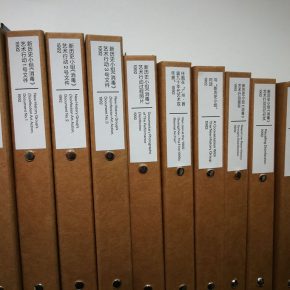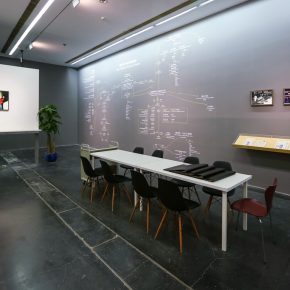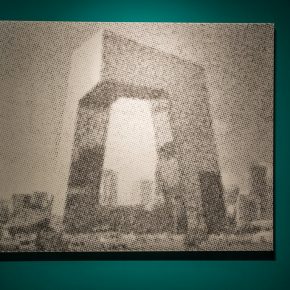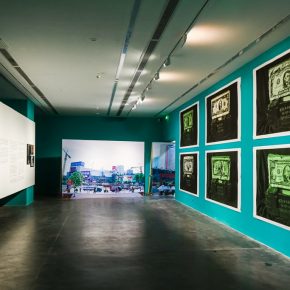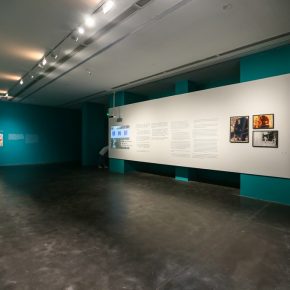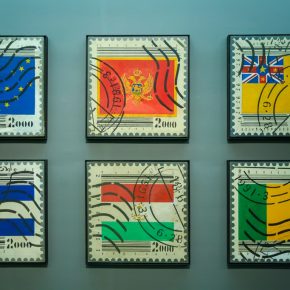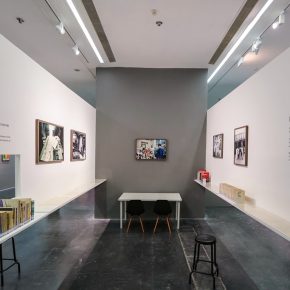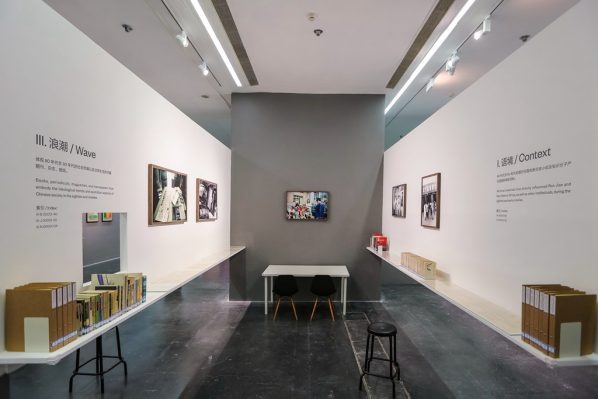
What do we really see when we are offered a retrospective of a period in history?
What are we going to summarize when we sort out our complicated archival materials?
How could we gain new knowledge by re-exhibiting the artworks marked by history?
Historical Scene
At 2 pm on 21st October 1992, immersed in the atmosphere of disinfectant, people were reading such a jocose text in the exhibition hall of “Guangzhou – The First 1990s Art Biennial (Oil Painting Section)”:
“Ladies and gentlemen: the exhibition opening ceremony is ready to start. We are at a most crucial time as we have invited art dealers, artists, critics from the U.S.A., Japan, France, Germany and other countries. In order to legitimize the exhibition, the organizer notices as follow:
Performance art is forbidden.
Tearing of paintings in the exhibition hall is forbidden.
Waving knives everywhere is forbidden.
We have already invited the leaders and soldiers from the National Armed Police Force to participate in the opening ceremony. Anyone who acts againstthe rules will be asked to account for their actions.
Again, the artistic host saluted to artists from all over the world. Many thanks again!” 1
Including life stories and thoughts of “Disinfection Action” participating artists, the analysis and criticism of the rules for the biennial award and the proposal of the second edition biennial by the suppositional “Wu Yangpi (五羊皮) World Art Exhibition Committee”, these distributed “disinfection” series of documents demonstrated the first group action of the “New History Group”. Lead by artist Ren Jian (b.1995), this “Disinfection Action” (1992) revealed and responded to the artist group’s anxiety and confusion due to the reformation of the national economic system and rapid social transformation towards consumer society under the Policy of Reform and Opening-up since the late 1970s.
In the early 1990s, as the first exhibition combining art with the market in China, “Guangzhou – The First 1990s Art Biennial (Oil Painting Section)” showcased the epoch-making significance to the Marketization of Chinese art; however, at the same time, it also intensively embodied the complicated contradictions of the state system, the ideological trends and individual emotions under the rapid transformation from the 1980s towards the 1990s.
The absorption and pursuit of western art trends since the last century have gradually generated a group of artists with idealistic enthusiasm and humanistic care in the “85’ Artistic New Trend” movement. In the early 1990s, although the development of a consumption mechanism within society has boosted the social transformation, the insufficient precipitation of the holistic value and the immaturity of the system of art industry in China have frustrated these ideal and enthusiastic artists. Confronting with chaos at the end of a century, the work of art lost its aura and began to take up more worldly concerns. Under these circumstances, artists were required to clean up, reorganize and classify everything (i.e. artistic values, artistic trends and social meanings). Getting lost in this disorderly situation, only a few artists have maintained the humanistic spirit.
“The Outcasts”
Born in the time of social transformation and contradictions, the New History Group intensively discussed and considered issues caused by the sudden arrival of the consumer society in the performance art “Disinfection Action”. The members of the New History Group confused about the rapid integration of art and the market then inspected issues left by the former ideology and artistic trends as well. Taking the first edition of Guangzhou Biennale as the experimental field, the New History Group proposed a notion of “immunity” to eliminate various “viruses”.
Overall, this “Disinfection Action” cleaned up and reflected on the sequelae of previous ideologies (i.e. the overflow of political and cultural symbols brought about by “Political Pop Art” in Chinese art); at the same time, it was an inquiry into the “collusion” mode of artists, critics and businessmen in the art field.
For the New History Group, “post-ideologies have been cleaned up through the Disinfection Action” 2 which may be the first step for constructing a new historical narrative. Later, through various group events such as “Consumerism Fair 1993”, the group intended to establish a relatively popular artistic language that could intervene into society utilizing art creation, thus realize an artistic behavior enabling the direct interaction between social activities and daily life. The Group believes that the alleged “humanistic spirit” would not be inherited unless the tide came over the baptism of the “flu” 3.
Besides Ren Jian and the New History Group, artist Chen Shaoxiong (1962-2016) also responded to the transitional period of society through his art creation. Based in Guangzhou, a city which is always active in the process of foreign trade and communication, Chen Shaoxiong presented an attitude of “bystander” and the consciousness of predestination. The innovative media in the early 1990s such as cameras, networks and computer programs were used experimentally by Chen Shaoxiong to observe the era and people in society. Both “Street” series of photo-collage works or public engagement works such as “In Collective Memory – Big Pants” has embodied Chen’s discussion and introspection of the turbulent era. He was purposefully banished and alienated himself from the city he lived in.
When artists are recording the era through their works, the era might counteract artists’ career of creation at the same time. Artist Wang Jin (b.1962) created a series of readymade works “Knocking on the Door” in the early 1990s, which printed seven presidents and historical figures found on different denominations of United States Dollars on to old wall tiles from the Forbidden City. This series of works portrayed how American currency was used to knock on the gates of contemporary China, opening the country to trade and serving as a symbol of its entrance into the global financial system. Apart from “U.S. Dollar Bricks” series, Wang has created different art installations and was involved in various performance art practices. “I was just getting start with ‘US Dollars Brick’. ‘Starting’ does not mean the beginning of my art creation. Instead, I began to bond my art creation with the current situation. In this case, the ‘US Dollars Brick’ depicted China’s conditions from 1992 to 1993 to some extent…” 4 Wang said frankly. The difference of ideological trends between China in the 1990s and the new millennium can be perceived through Wang’s previous works and the work presenting more personal emotions entitled “My Bone (Wodegu, 我的骨)” in 2000. In other words, Wang’s art creation has been growing up in line with the development of the era, and his works in the period of “U.S. Dollar Brick” have been transformed to be a symbolic seal witnessing the social changes of China in the 1990s.
Looking forwards? Looking backwards!
The mark of the era has been left behind, but the flood of history is still rolling forward. Nowadays, the notion of consumption has become immersed in every aspect of collective society and daily life. A retrospective of the gap and lack of value brought about by social transformation in the early 1990s, and the public’s complex emotions of anxiety, disturbance as well as expectation of the newly-established value system, some issues growing in that era have been sorted out, while others are still attached to new cultural and social problems, and continuously discussed by people.
By dating back the Chinese history and society in the 1990s briefly, it is clear to see that the recent exhibition “Society Guidance: Part I” in UCCA reviews as well as the social transformation and artistic trends in 1990s. Based on this, the exhibition is also designed to trace the origin of the current cultural dilemma from a certain point in history. By reuniting artists Re Jian and the New History Group, Wang Jin and Chen Shaoxiong, the exhibition discusses the social and ideological evolution in the late 1980s and early 1990s in China, and lays the foundation for the second part of “Society Guidance” which would feature diversified artists and their works in the middle and late 1990s in China. Regarding the curatorial methodology, curator Bian Ka emphasized that the exhibition is more than a historical and archive representation; it should be used as the starting point to reconsider how history could facilitate the current situation.
It seems that the “Society Guidance: Part I” constructs the field that brings audiences in the 21st century back to the early 1990s; however, at the same time, it expects dynamic dialogues about historical topics in the current situation.
Specifically, when spectators stop and interact with “Landscape-3” by Chen Shaoxiong, and make the selection of their first impression in terms of the notion of “landscape”, the diversified contemporary understandings of “landscape” appears. When Wang Jin’s “U.S. Dollar Brick” is presented in a way through amplified photographs highlighting the painting techniques of figures instead of readymade objects being represented, the original ideological entanglement seems to be dispelled. When the “New History Reading Room” opens to the public during the exhibition, the visitors can browser artworks, literature and archival materials and discuss the group’s artistic practices based on their knowledge and personal experience.
In the opening ceremony of the exhibition, artist Ren Jian re-emphasized a notion of “folded” historical view he proposed, which indicates that the linear historical writing could be opened to multiple perspectives. It offers people a retrospective of history not only from a single famous historical event; instead, it encourages diversified opinions and individual interpretations in terms of representing history 5.
Following by Ren Jian, Gong Ke, the member of the New History Group, recalled the idea of “looking backwards”. The group proposed this idea during the period of confusion of artists in the late 1980s and early 1990s. After cleaning up the pre-ideologies and artistic trends in the middle 1980s, artists in China puzzled about the notion of avant-garde and the way to step forward. At this time, the idea of “looking backwards” illumined a way to find the order for a group of artists:
“we do not know what the future looks like, but we do know where is the past. Hence, we look back to history for orderliness. This might be the starting point of the New History Group 6.”
In this case, with the retrospective focus, the exhibition “Society Guidance: Part I” reorganized this period of history and presented it into the discussions at present, which intends to trace the present conditions back to their origins. It seems to coincide with the idea of “looking backwards to search for orderliness”.
Through establishing connections between the archives and artworks, a certain period of history is marked and the social and cultural context is at present recognized. Can the exhibition guide the future and sustainable discussions?
Epilogue:
In Ren Jian’s “Stamp Collecting” series, the use of barcodes may not be due to timing. The significance of a barcode lies in the specific certification of a particular commodity. The New History Group believes that art should be self-certificated before it is delivered into the market. Nowadays, when the artistic notions of reference, plagiarism and appropriation frequently appear in the public’s vision and discussion, the self-certification and identities of artists turn out to be particularly significant. It is not only a historical discussion developed to a hotspot at present but is also a sustainable topic in the future. In this case, referencing Gong Ke’s words, “the utopian solution to the problem of artists’ self-certification would be — ‘everyone is an artist.’” 7
Bibliography:
1 Selecting from the 3rd document in the “Disinfection” series: Notice No.35;
2 Hu Bin, A Brief Historical Review of New History ART GROUP in Wuhan 1990s, Contemporary Art and Investment J, 2009
3 Ren Jian, Dialogue with “New History Group”, Contemporary Art and Investment J, 2009
4 Selecting from Art Archive – Wang Jin, May 2010, http://www.artda.cn/view.php?tid=3643&cid=28. Accessed on May, 2019
5 Selecting and reorganizing from artist Ren Jian’s speech in the opening ceremony of the exhibition “Society Guidance: Part I” in UCCA in May, 2019.
6 Selecting and reorganizing from a member of New History Art Group, Gong Ke’s speech in the opening ceremony of the exhibition “Society Guidance: Part I” in UCCA in May, 2019.
7 ibid.
Text by Emily Weimeng Zhou and edited by Sue/CAFA ART INFO
Photograph by UCCA and CAFA ART INFO


